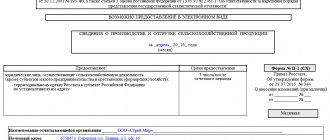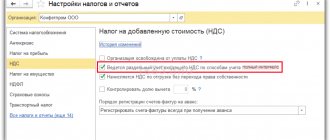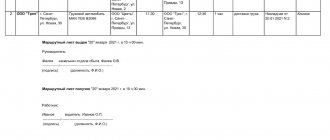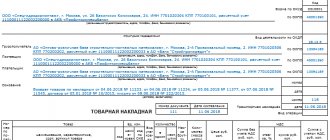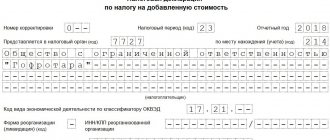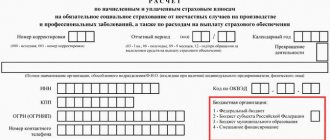Who submits Form 1-Services
Form 1-Services is used to report to everyone who provides paid services to the population. This applies to organizations, individual entrepreneurs and legal entities (with the exception of law offices).
Until 2021, form No. 1-IP (services) was provided for individual entrepreneurs, but now it has been canceled. For 2021, entrepreneurs will submit Form 1-Services, just like a legal entity.
Individual entrepreneurs who are engaged in the fields of agriculture, insurance, retail trade or public catering do not need to report on the form.
As for small businesses, not all of them will have to submit a report for 2021. In accordance with Art. 5 No. 209-FZ, statistical observation of the NSR is carried out on a selective basis. If your company is included in the sample, you will be sent a letter. But Rosstat does not always do this, so it is better to call the statistics service department in advance or check all mandatory reports on the official Rosstat website. Ignorance of the need to report will not exempt you from fines.
Once every five years, a comprehensive survey of business entities is carried out. The next time it is expected is in 2021, so be ready to report back.
How to fill out the 1-IP form without errors
The form is very compact and fits into three sheets. The composition of form 1-IP is as follows:
- title page;
- the main part, consisting of five questions, the answers to which are the necessary data to fill out.
Title page
Entrepreneur registration details are entered here:
Full name; postal address (please note that it is the postal address, and not the registration address, provided they do not match); OKPO; TIN.
Main section
After entering your data, the entrepreneur must answer five questions:
- The question is about the very fact of entrepreneurial activity. If business activity was carried out for at least one month out of the entire year, then you must answer “Yes”, go to question 3 and subsequently answer questions only regarding this activity without taking into account activities under employment contracts (if this also took place in the reporting year).
- Only those who answered “No” to the first question proceed to this question. And there are only two options here: “Yes” and “No”.
After answering question 2, you can complete the calculation. Sign, date and turn in.
- Those who answered “Yes” to question 1 go to question 3. Here it is necessary to indicate the volume of revenue with the following features:
- we take the proceeds including VAT and other similar taxes;
- We show revenue for all types of activities in total.
- In this paragraph we describe all types of activities that the individual entrepreneur carried out during the reporting period. Clause 4.1 – percentage share of each type of activity.
- The question is about the number of persons who participate or assist the individual entrepreneur in its activities. There are:
- partners - participate in the business on the terms of some kind of contribution and perform some work;
- helping family members - relatives who help individual entrepreneurs conduct business activities;
- hired workers - persons performing work for remuneration
At the end of the form, you traditionally need to sign, indicate the date, email and telephone number.
Deadlines and procedure for submitting Form 1-Services
Form 1-Services is submitted annually. In 2021, you need to report for 2019. The deadline for this is no later than March 1. But since the date falls on Sunday, the report can be submitted on Monday, March 2.
If you are a small enterprise, but were not included in the list of those required to report before this deadline, it means that you managed to avoid the survey this year.
The form can be submitted in paper or electronic form. Place of delivery - territorial bodies of Rosstat:
- for organizations - according to legal company address or place of actual business;
- for separate units - at location;
- for individual entrepreneurs - at the place of registration or at the place of actual business, if they do not coincide.
For organizations with separate divisions, several forms are required. It all depends on the area where you are located. If a legal entity and separate divisions are located in the same entity, then they submit one form; if in different ones, a separate form for each division and a separate one for the legal entity.
In what form should the report be submitted?
On paper
Submitting a report on paper is extremely simple:
- Download form 1-yes.
- Complete the title page and sections.
- Take it to the local statistical office.
The completed form can be submitted by the manager or representative of the enterprise, but only after presenting a power of attorney signed by the head of the enterprise.
Electronic
Electronic reporting, which is submitted via telecommunication channels (TCC), is a more convenient method.
Algorithm for submitting an electronic report:
- Download and install the software.
- Fill in the fields of the form.
- Send to recipient.
The electronic form has additional requirements for the design and preparation of the questionnaire:
- You need to submit the completed form only in XML format;
- An incorrectly completed form, non-compliance with the file format, violation of arithmetic and logical calculations are considered false information, for which a fine or resubmission of the report will be imposed.
The stated procedure for receiving and processing statistical information, approved by Rosstat Order No. 370 dated October 27, 2007, contains the following information on processing and reporting:
- Primary reporting submitted after the deadline, even in XML format, is unreliable and is considered not submitted. This entails administrative penalties.
- If the respondent reported electronically, then the statistical authorities do not have the right to require filling out a paper form.
How to fill out form 1-Services
Report form 1-Services is otherwise called OKUD 0609703 and approved in Appendix No. 4 to Rosstat Order No. 418 dated July 22, 2019. For the report for 2021, several innovations have appeared, so the procedure for filling out the form has also changed.
Form 1-Services is small, it includes a title page and two sections. In them, organizations and entrepreneurs must talk about the types and volumes of paid services for the population and make a breakdown by territory (for legal entities).
Before proceeding to filling it out, it is worth considering several nuances that determine the need to enter information into the form. Information in the report should include service providers who accepted the order from the consumer themselves and directly received payment from him. Therefore, you do not need to take into account revenue if:
— The service provider received payment from his client’s employer. For example, an organization bought an employee a trip to a sanatorium: the cost of the trip in the report is reflected by the employer, not the sanatorium.
— The service provider engaged a third party to place an order or receive payment from the consumer. For example, a transport company sells tickets through an agency. The data in the report is included not by the transport company, but by the agency. In this case, the intermediary fee is taken into account.
Let's take a closer look at the process of filling out the form.
Title page
On the title page you must disclose all the basic information about yourself. The data for organizations and entrepreneurs is slightly different.
In the address part of the company indicate its full name, as indicated in the constituent documents, and its abbreviated name. For separate divisions, indicate its name and the name of the legal entity to which it belongs. Individual entrepreneurs indicate only their full name.
In the “Postal Address” line, the legal entity indicates the legal address and the actual address, if they do not match. Separate divisions without a legal address provide a postal address and zip code. The individual entrepreneur indicates the postal address at the place of registration.
Section 1
In the first section, the respondent must talk about the volume of services provided to citizens on a reimbursable basis during the year. The scope of services is indicated:
- in prices valid at the time of payment;
- in thousands of rubles;
- including VAT and other payments;
- taking into account the cost of materials necessary to provide the service;
- with one decimal place.
Receipts are distributed by type of service line by line.
Line 01 is the result. It contains the total volume of services that the respondent provided to the population during the year on a reimbursable basis. Consumers of services can be citizens of the Russian Federation and other countries.
The volume of services from line 01 is distributed across lines 02 - 31 by type of service based on OKPD2.
In lines 02 - 14, indicate household services to the population. From the nuances:
- on line 04 it is necessary to indicate the cost of certificates for additional maintenance of equipment and equipment that the population purchases to extend warranty service;
- line 05 indicates repair services for vehicles and motorcycles, which are provided at the expense of insurance companies.
In lines 15 - 17, indicate transportation and communications services: transportation, mail, couriers, telecommunications services.
Line 18 indicates housing services. A limitation has been introduced as of the 2021 report. Thus, this line does not need to reflect contributions for major repairs (for owners of premises in apartment buildings) and the amount of utility resources for the maintenance and use of common property.
In line 19, the volume of services is provided by organizations and local authorities that supply residents with resources: electricity, heat, water. This includes utility payments from the population, as well as the supply of fuel and household gas to citizens.
In line 21, travel agencies show the full cost of the tourism product sold directly to the public. It could be formed by both a resident and a non-resident of the Russian Federation. Payments to foreign service providers do not need to be included here.
Lines 22 and 25 are very similar in content - both involve population placement. But line 22 is for hotels, hotels, hostels, etc. that clean their rooms every day. Line 25 - for campsites, camps, recreation centers, resorts, etc.
Line 28 is relevant for legal entities. It reflects remuneration for legal assistance to citizens and compensation for expenses. Other organizations providing similar services enter data in line 31.
Line 31 indicates all other paid services that were not included in the previous lines.
Section 2
The second section was introduced for the 2021 report. It is intended for organizations (except small businesses) only. In it, companies distribute paid services to urban districts and municipal areas. The section is completed for each separate division.
The new section is quite simple. The first column indicates the name of the entity where the service was provided. In the second column is the OKTMO code. The third column shows the volume of paid services for this education.
When filling out, do not forget about the control ratio: the sum of the lines in column 2 must be equal to the number in line 01 in column 4 of section 1.
Form 1-Services Sample form 1-Services
Legislative framework of the Russian Federation
valid Editorial from 17.07.2013
detailed information
| Name of document | ORDER of Rosstat dated July 17, 2013 N 284 “ON APPROVAL OF STATISTICAL INSTRUMENTS FOR ORGANIZING FEDERAL STATISTICAL SUPERVISION OF ADMINISTRATIVE OFFENSE IN THE FIELD OF ECONOMY, MARKET ON APPROVAL OF STATISTICAL INSTRUMENTS GUIDELINES FOR ORGANIZING FEDERAL STATISTICAL MONITORING OF ADMINISTRATIVE OFFENSE IN THE FIELD OF ECONOMY, MARKET "Postal address" indicates the name of the territory of the Russian Federation Federation, legal address with postal code. If the actual address does not coincide with the legal one, then the postal address where the legal entity is actually located is also indicated. In the code part, a legal entity must enter the code of the All-Russian Classifier of Enterprises and Organizations (OKPO) on the basis of the Notification of assignment of the OKPO code sent (issued) to organizations by the territorial bodies of Rosstat. In section 1, column 3, one of the lines 02 16 is noted, corresponding to the main type of activity of the organization. In sections 2 - 4, answers are given only for the main type of activity (which is noted in section 1). In section 2, the answers are given on lines 17 - 25 in one of columns 3 - 5, 6 - 8, 9 - 11. When filling out line 21, you must keep in mind that investments are any investments of funds (own, attracted from outside) for the purpose of making a profit (for the purchase of transport, equipment, repairs, for training specialists, etc.). If there were no investments in the current quarter, then line 21 is not filled in at all. If the organization did not carry out its activities in the quarter preceding the reporting (current) quarter, then in section 2 it fills out lines 17 - 25 according to one of columns 3 - 5, 9 - 11 and column 7. If the organization does not plan to carry out activities in the next quarter after the reporting (current) quarter, then in section 2 it fills out lines 17 - 25 according to one of columns 3 - 5, 6 - 8 and column 10. In section 3, the answers are given on one of lines 26 - 28 in columns 3, 5, 6. If the organization did not carry out its activities in the quarter preceding the reporting (current) quarter, then in section 3 it fills out one of lines 26 - 28 in columns 3, 6 and line 27 in column 5. If the organization does not plan to carry out activities in the next quarter after the reporting (current) quarter, then in section 3 it fills out one of lines 26 - 28 in columns 3, 5 and line 27 in column 6. Section 4 is completed only in the report for the first and third quarters of the reporting year. In this case, in the report for the first quarter of the reporting year, the “previous period” is considered to be the previous year, and in the report for the third quarter, the first half of the reporting year. If the organization did not carry out activities in the “previous period”, then on lines 29 - 33 it puts marks in column 4. Section 5 of the form indicates one or more answer options. Section 6 (subsections 6.1, 6.2) is filled out by organizations engaged in tourism activities (with the exception of excursion activities). In subsection 6.1, line 46 is filled in by an organization that is both a tour operator and a travel agent, line 47 is only a tour operator, line 48 is only a travel agent. In subsection 6.2, the answers are given in lines 49 - 51 in column 3, in one of columns 4 - 6, 7 - 9, 10 - 12. If the organization did not carry out its activities in the quarter preceding the reporting (current) quarter, then in subsection 6.2 it fills out column 3, one of columns 4 - 6, 10 - 12 and column 8. If the organization does not plan to operate in the next quarter after the reporting (current) quarter, then in subsection 6.2 it fills out column 3, one of columns 4 - 6, 7 - 9 and column 11. Section 7 is filled out by organizations that provide intermediary services in the purchase, sale and rental of real estate (except for appraisal activities). In subsection 7.1, the answers are given in lines 52 - 63 in column 3, in one of columns 4 - 6, 7 - 9, 10 - 12. If the organization did not carry out activities in the quarter preceding the reporting (current) quarter, then it fills out column 3, one of columns 4 - 6, 10 - 12 and column 8. If the organization does not plan to carry out activities in the next quarter after the reporting (current) quarter, then it fills out column 3, one of columns 4 - 6, 7 - 9 and column 11. In subsection 7.2, the answers are given on lines 64 - 69 in one of columns 3 - 7 and 8 - 12. If the organization did not carry out activities in the quarter preceding the reporting (current) quarter, then it fills out one of columns 8 - 12 and column 6. If the organization does not plan to carry out activities in the next quarter after the reporting (current) quarter, then it fills out one of columns 3 - 7 and column 11. Control between sections If line 10 of section 1 is completed, then section 6 is completed. If line 16 of section 1 is completed, then section 7 is completed. If at least one of lines 52 - 57 of subsection 7.1 is completed, then subsection 7.2 is completed. |
Zero form 1-Services
The Statistics Service provided for the submission of a report on services even if activities were not carried out or suspended during the year.
If an organization or individual entrepreneur has not worked all year, then they submit a report in the general manner, but enter zeros in the lines.
Organizations that have been operating for only part of the year submit the form on a general basis and indicate since when they have not been operating.
If an organization or individual entrepreneur did not provide services to the population in 2019, then instead of a form, you need to send an official letter to Rosstat about the absence of the event under study.
Statistics: form No. P (services) as amended
There are no fundamental changes in the structure or content of the new form, and those changes that exist are rather of a technical nature, simplifying and concretizing work with the document.
Let us indicate in more detail what has changed in the form P (services), which business entities will have to work with from 2020.
- Title page:
- In the “Provide” column of the title page, which lists business entities submitting this type of statistical reporting, legal entities whose average number of employees does not exceed 15 people are excluded.
- In the “Delivery Deadlines” column of the title page, the requirement to submit a report “Quarterly, no later than the 15th day after the reporting period,” which applied to legal entities with up to 15 people, is excluded.
- Statistical block:
- The regulatory instruction “OKEI code: (with one decimal place) one thousand rubles – 384” was removed, and the heading “Volume of paid services to the population, one thousand rubles” appeared.
- In column “4” the clarification “(with an average number of employees up to 15 people - for the period from the beginning of the year)” is excluded.
- In the summary part, the comment is excluded: “1To be completed only by organizations with an average number of employees of more than 15 people.”
The procedure for submitting 1-IP to statistical authorities. Who, when and where reports
Form 1-IP is called “Information on the activities of an individual entrepreneur. Obviously, this form is presented only to individual entrepreneurs. There are some exceptions from the list of respondents:
Please note that if an individual does not have the status of an individual entrepreneur and pays tax on professional income, then he does not have the obligation to submit 1-IP.
The report should be compiled and sent to the regulatory authorities only if the entrepreneur is on the list of respondents who must submit this form at the end of the tax period. You can find out your fate regarding being included in the list by receiving an information letter from the statistical authorities, or on the official website of the statistical service by entering your TIN.
Form 1-IP 2021 applies to annual reports, that is, it must be submitted only once a year, no later than March 2 of the year following the reporting year.
The place of reception is the territorial statistics office.
Form 1-IP - filling out
Under the general information about the form, the entrepreneur must indicate the postal address (zip code, registration address), in the line “Individual entrepreneur” indicate the full name and put a personal signature. A sample form 1-IP will be provided at the end of the article.
The following contains general information about the report: the year for which the information is submitted, the name of the form, an indication of who must submit it, the deadline for submission, as well as the OKPO code and the entrepreneur’s TIN.
The main part of the form consists of five questions (sections). We will provide a sample of filling out Form 1-IP at the end of the article. The first question that an entrepreneur must answer is whether the activity was carried out in the current year? There are two answer boxes to choose from: “Yes” or “No”. If no activity was carried out, the entrepreneur is o, and in this case the remaining columns of the form do not need to be filled out.
In the second question, the entrepreneur must answer whether he carries out his main activities in the same subject of the Russian Federation in which he was registered. If the address is different, you must indicate the place of main activity in a separate field.
Next, the entrepreneur needs to indicate the amount of revenue he received in the reporting year in all areas of activity (indicated in thousands of rubles). If payment was received in kind (for example, in the form of goods), then the amount of revenue will be determined based on the transaction price. If the transaction price cannot be determined, revenue will be determined based on market prices.
The fourth question of the Rosstat study, which an entrepreneur needs to answer, contains information about the types of activities that were actually carried out in the reporting year. All types of services (or manufactured products) that were produced by the individual entrepreneur in the reporting year should be listed. The answers to this question are recorded in each space provided in as much detail as possible. It is also necessary to indicate the share of revenue received from each type of activity (in percentage). To indicate this information in the 1-IP form, the form has several separate fields.
Next, the entrepreneur reflects how many people worked in his business - not only employees and partners are indicated, but also helping family members. The average number must be calculated separately for each category as follows: add the number of persons who worked in each calendar month and divide by the number of months the individual entrepreneur worked (if the individual entrepreneur worked for a full year, then divide by 12). Data obtained in this way must be rounded to the nearest whole number.
When filling out this item, it is very important to correctly divide employees into categories. Thus, individual entrepreneurs who have entered into a civil law agreement with an entrepreneur and pay their own taxes cannot be considered employees.
In general, employees are considered to be citizens who perform work for a certain fee on the basis of both a written contract and an oral agreement.
